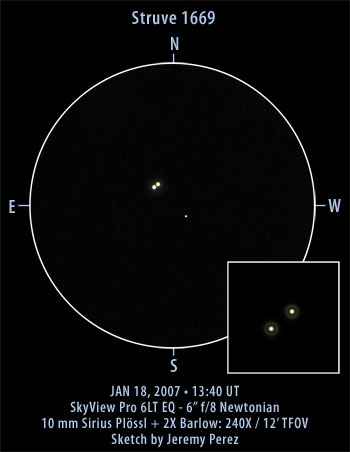
Observation Notes:
About a degree and a half south of the Sombrero Galaxy, M104, you’ll find the multiple star, Struve 1669. The main attraction here is a pair of 6th magnitude F class stars. When observing them, don’t forget to take in a third, tenth-magnitude star 1 arc minute to the southwest. The two brighter stars appeared to be separated by about 4 arc seconds, and resting at a PA of 315 degrees. Values in the Washington Double Star Catalog list 5.4″ from 1828 and 312 degrees from 1991. Color was tough to nail down, and I eventually settled for pale yellow for the northwest star and white for the southeast companion. Give it a look the next time you’re dancing around that nearby galactic hat and see what colors you perceive.
| Subject | Struve 1669 |
| Classification | Multiple Star |
| Position (J2000) | Corvus [RA: 12:41:15.8 / Dec: -13:00:49]* |
| Position Angle* | AB: 312° (1991); AC: 235° (1900) |
| Separation* | AB: 5.4″ (1828); AC: 59″ (1900) |
| Magnitudes* | A: 6.0; B: 6.1; C: 10.5 |
| Spectral Types* | F5V; F5V; – |
| Date/Time | JAN 18, 2007 – 06:40 AM MST (JAN 18, 2007 – 13:40 UT) |
| Observing Loc. | Flagstaff, AZ – Home |
| Instrument | Orion SVP 6LT Reflector (150 mm dia./1200 mm F/L) |
| Eyepieces/Mag. | 10 mm + 2X Barlow (240X) |
| Conditions | Clear, calm, 11° F |
| Seeing | 4/10 Pickering |
| Transparency | NELM Mag ~5.0 |
| References | The Washington Visual Double Star Catalog, 1996.0 (Worley+, 1996) |
*Based on published data.